How to Read and Understand Ingredient Labels (and Why)
Reading and understanding ingredient labels is the most powerful tool you have for making intelligent food choices.

Have you ever been tempted to buy a healthy-looking fruit bar only to discover that those fruit bars don’t even contain any fruit!? Or maybe you wanted some guacamole dip, but then after reading the ingredient list you discover there are no avocados in the dip? This is actually very common among packaged food. And that’s why, if you buy packaged foods and you want to eat healthfully, you need to read the ingredient list.
Reading and understanding ingredient labels is the most powerful tool you have for making intelligent food choices. The ingredient label is how you can know what’s actually in the food you are considering purchasing.
What About the Nutrition Facts Label?
When I say ingredient label, I’m not referring to the Nutrition Facts (I talk more about this in another post), but rather the actual ingredients.
The Nutrition Facts Label can be misleading.
For example, let’s take a look at these Ritz Crackers.
The Nutrition Facts Label says these crackers have 0 trans fats. Sounds good, right?
Unfortunately, it isn’t that simple. Sometimes manufacturers will manipulate serving sizes so a particular food contains 0.5 gram or less trans fats per serving. If they do that, they can then claim that the product is trans-fat free. But because the serving size is so unrealistically small, the average person may eat 6 servings at one sitting and thus unknowingly consume 3 grams of trans fats (a very unhealthy amount).
The only way to avoid this mistake is to check the ingredients.
Another example: The Nutrition Facts on sugar-free Creamsicles says that they are low in calories and have 0 grams of fat and 0 grams of sugar.
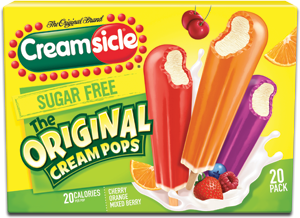
Sounds healthy until you take a look at the ingredients:
Ice Shell [water, sorbital, polydextrose, citric acid, malic acid, guar gum, natural and artificial flavor, ascorbic acid, acesulfame potassium, locust bean gum, sucralose (Splenda® brand), red 40, yellow 6, yellow 5, blue 1] Frozen Dessert [water, maltodextrine, polydextrose, milk protein concentrate, sorbital, glycerine, palm oil, cellulose gum, mono & diglycerides, guar gum, cellulose gum, locust bean gum, acesulfame potassium, carrageenan, natural and artificial flavor, sucralose (Splenda® brand), caramel color]
Whoa! What is that stuff!? They may be sugar-free, but I don’t think anyone could mistake those ingredients for real food.
Understanding Ingredient Labels
Ingredients are listed in descending order of weight.
So, for example, if the ingredients go like this:
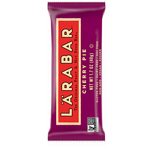
Dates, almonds, unsweetened cherries
that means there are more dates than almonds, and more almonds than cherries in this LARABAR.
And if an ingredient list goes like this:

Granola (whole grain oats, sugar, canola oil, fructose, salt, baking soda), corn syrup, sugar, rice flour, whole grain wheat, honey, palm kernel oil, dextrose, maltodextrin, canola oil, soy lecithin, yogurt powder (non-fat milk, whey protein concentrate, cutures) calcium carbonate, nonfat dry milk, strawberry powder, barley malt extract, salt, natural flavor, mixed tocopherols
then there are more oats than sugar and more corn syrup than whole grain wheat in this Nature Valley Strawberry Yogurt Granola bar .
And there are NO strawberries!!!!!!!!
By reading the ingredient list, you can determine if the ingredients in this product are ingredients that you want to include in your diet. And while the ingredient label doesn’t tell you exact quantities of ingredients, it does tell you relative quantities of ingredients.
Tricky Tricks to Watch For
When reading and understanding ingredient labels there a few things to be aware of.
1. Where’s the Whole Grain?
Wheat flour sounds healthier than white flour, right? Unfortunately, all flour derived from wheat can be called “wheat flour,” even if it is processed white flour. This includes durum flour, semolina flour, enriched flour, stoneground flour, etc. Unless these ingredients have the word “whole” in front of them, they are most likely refined flours. Only if the ingredient list says “whole” in front of the grain or flour is it truly made from whole grains.
Same with other flours – like rice flour and barley flour. Unless the ingredients list “brown” rice flour or “whole” rice flour or “whole-grain” barley flour, the product is probably made with white rice flour or refined (pearl) barley.
2. Sneaky Sugar
While an ingredient list doesn’t tell you how many teaspoons (or cups!) of added sugar are in a serving, you can get a good idea of how much added sugar is in the product by noticing where sugar comes in on the ingredient list. A product that lists sugar in the first two ingredients most likely has more sugar than a product that has sugar last or second to last on the ingredient list.
The tricky part is when a food manufacturer includes more than one kind of sugar in the product. If the total refined sugar amount is divided among two or three (or more) sugars they may appear low on the ingredient list, making us believe that the amount of sugar in the product is smaller than it is. But if they took all those sugars and added them together, they would often be first in the ingredient list.
For example, take a look at the ingredients in this Quaker Chewy granola bar.

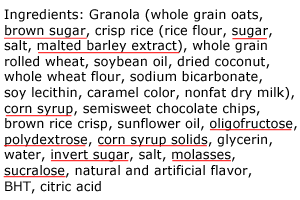
Scattered throughout the ingredient label are several sugars, including brown sugar, sugar, malted barley extract, corn syrup, oligofructose, polydextrose, corn syrup solids, invert sugar, molasses, sucralose … and the chocolate chips and rice crisps probably have some sort of sweetener in them as well. If we were to add all these sweeteners together, the sugar would most likely would be at the top of the ingredient list. But the way they are listed here, it doesn’t seem all that bad.
I wrote a post about hidden sugar and how to avoid it.
Here is a list of the many different names for sugar and other commonly-used sweeteners.
3. Tricky Trans Fats
You won’t find trans fats actually listed in the ingredient label, but rather ingredients that contain trans fats. These include partially hydrogenated oil and hydrogenated oil.
4. In-Disguise Ingredients
Some ingredients are listed under names that aren’t as easily recognized. For example, MSG can be found in yeast extract, hydrolyzed vegetable protein, glutamic acid, and soy protein isolate. Caffeine (from different sources) is sometimes listed as camellia. Carmine or natural red 4 comes from the cochineal insect.
The best way to avoid in-disguise ingredients is to read the ingredient label. Or eat natural, whole foods that don’t need ingredient labels, like fruit, vegetables, whole grains, legumes, nuts, and seeds.
What Ingredients Should I Avoid?
There is an ever-expanding number of unhealthful ingredients used in food products today, so rather than memorize what I don’t want to consume, I just try to do be sure all the ingredients on the ingredient list are ones that I would be comfortable using in my own kitchen. I try to choose whole foods in their natural unrefined state as much as possible.
For me, this list is simple: Whole grains, fruits, vegetables, legumes, nuts, and seeds. Real foods. Simple foods. Plant-based nutrition.
A Few Final Notes
You may have heard it said, “Avoid any food with an ingredient list that has more than 5 ingredients”. While there may be some truth in this in a general sense, it doesn’t always apply. There are plenty of 5-ingredient foods that I would stay away from. For example, Smuckers Apple Jelly has only 5 ingredients: apple juice, high fructose corn syrup, corn syrup, fruit pectin, citric acid.
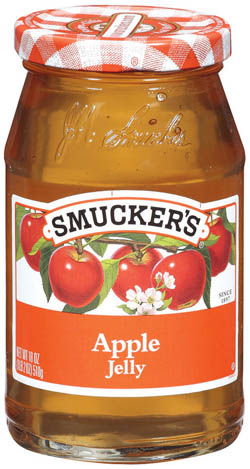
It would be silly to think this was a healthier option than a trail mix with 8 ingredients (such as almonds, pumpkin seeds, raisins, coconut, walnuts, dates, dried apples, and sunflower seeds).
It has also been suggested to avoid any products with ingredient lists containing words you can’t pronounce. While it is a good policy to avoid chemicals and additives – which are usually listed by long, unpronounceable names – just because you don’t know what an ingredient is, doesn’t mean it isn’t healthy. Ever had Rambutan, Cupuacu, adzuki beans, tahini, cassava, or Komatsuna ? These are all healthy ingredients – just not commonly heard of and maybe not so easy to pronounce. 🙂
Healthy Choices
So to make the best food choices, ignore the front of the box and all the health claims. Go straight to the ingredients and know what’s in your food. Understanding ingredient labels is an important key for good health.
Want help eating more healthfully? Join my Weight Loss Program and you’ll discover how you can eat delicious food, not count a single calorie, and watch the weight fall off.
You my also like:
Before you go . . .
Did you know that you can eat all this delicious food AND lose weight? You can!
No calorie counting. No portion sizes.
Join my online weight loss program today!

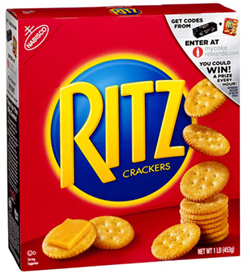


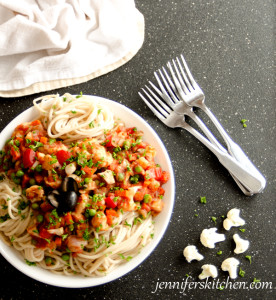
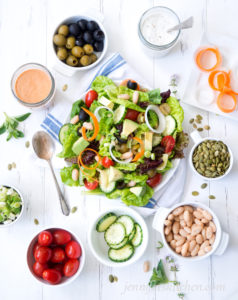
Great article! I will look at the ingredient list differently from now on when I’m buying processed foods, especially to look out for all of the different sweeteners used.
I’m glad is was helpful, Emily. Thank you for your comment. 🙂
I agree, knowing how to read ingredient labels seems like a great way to not only lose weight, but also live a healthier life. Keeping track of all of the ingredients that goes into your body can have a great affect on your health. Being on the look out for certain ingredients that negatively affect your health is important to keep in mind when shopping for food. I agree, there are several food companies that try to disguise ingredients containing MSG and other harmful chemicals that people normally try to avoid. It helps that you’ve listed a few ingredients in this article that people want to avoid. I didn’t know that MSG can be found in yeast extract and soy protein isolate. Does that mean that vegemite and marmite contain MGS? I know that they’re made from yeast, so I’m very concerned that they may contain MSG.
Yes, vegemite and marmite do, as do many fermented foods. The best diet is one made from fresh fruits, vegetables, whole grains, legumes, nuts, and seeds.